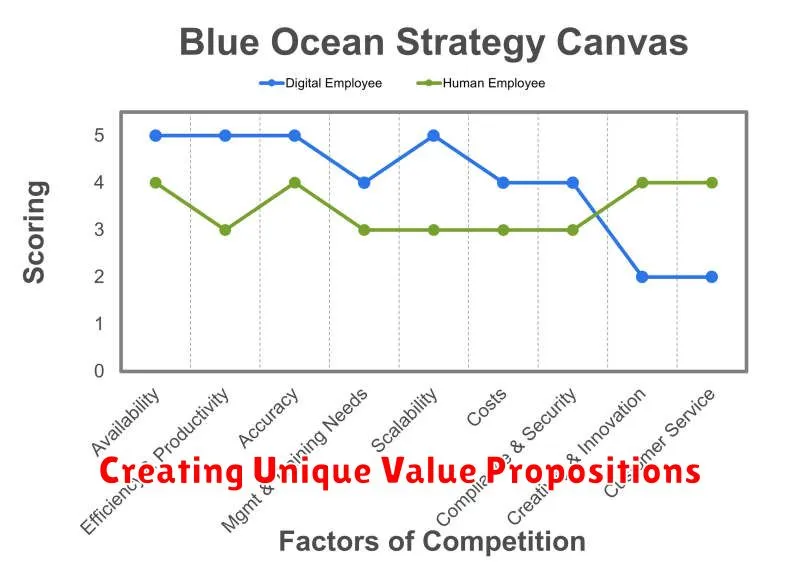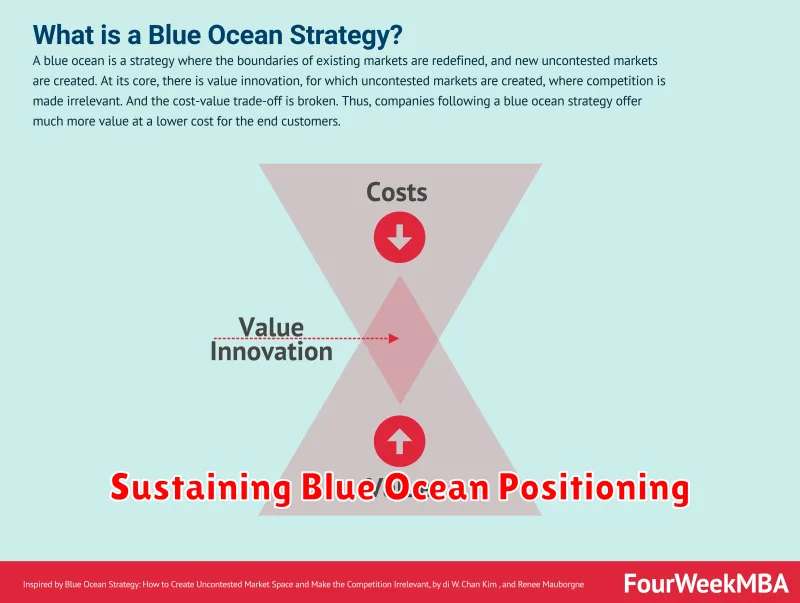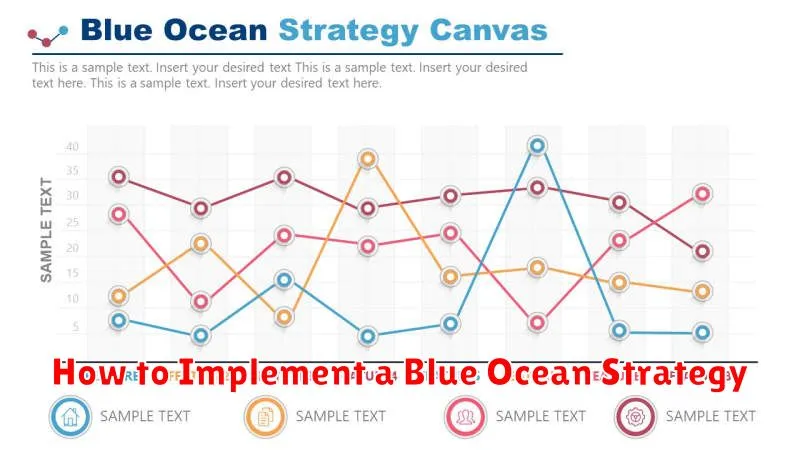In today’s competitive market landscape, businesses constantly seek strategies to differentiate themselves and achieve sustainable growth. The Blue Ocean Strategy presents a compelling framework for achieving this, offering a path to uncontested market space and away from the bloody “red ocean” of cutthroat competition. This article will delve into the practical steps required to implement a Blue Ocean Strategy, providing actionable insights to create new market demand and achieve unprecedented value innovation. Understanding the core principles of Blue Ocean Strategy—value innovation, creating new demand, and breaking the value-cost trade-off—is crucial for businesses aiming to escape the limitations of existing market boundaries. Learn how to identify untapped market potential and position your business for unparalleled success.
Implementing a Blue Ocean Strategy is not simply about finding a niche; it’s about creating a whole new market space where competition becomes irrelevant. This involves a systematic approach to reconstructing market boundaries, challenging industry conventions, and focusing on non-customers. This article will guide you through the process of formulating and executing a Blue Ocean Strategy, covering the key analytical tools and frameworks, including the Four Actions Framework and the Strategy Canvas. Discover how to shift the focus from competing with existing rivals to creating new market space and capturing untapped demand, leading to Blue Ocean creation and exponential growth.
What Is Blue Ocean Strategy?
Blue Ocean Strategy is a market-creating approach to business growth. It contrasts with red ocean strategy, where businesses compete in existing, often overcrowded market spaces.
In red oceans, industry boundaries are defined and accepted, and the competitive rules of the game are known. Companies try to outperform their rivals to grab a greater share of existing demand. As the market space gets crowded, prospects for profits and growth are reduced. Products become commodities, and cutthroat competition turns the ocean bloody red.
Blue oceans, in contrast, denote all the industries not in existence today – the unknown market space, untainted by competition. In blue oceans, demand is created rather than fought over. There is ample opportunity for growth that is both profitable and rapid.
Red Ocean vs Blue Ocean Explained
The Red Ocean represents all the industries in existence today – the known market space. In red oceans, industry boundaries are defined and accepted, and the competitive rules of the game are known. Here, companies try to outperform their rivals to grab a greater share of existing demand. As the market space gets crowded, prospects for profits and growth are reduced. Products become commodities, and cutthroat competition turns the ocean bloody red.
The Blue Ocean, in contrast, denotes all the industries not in existence today – the unknown market space, untainted by competition. In blue oceans, demand is created rather than fought over. There is ample opportunity for growth that is both profitable and rapid.
Identifying Uncontested Market Space
A cornerstone of Blue Ocean Strategy is identifying uncontested market space, also known as a “blue ocean.” This represents an area where competition is minimized and new demand is created, as opposed to competing in existing, crowded markets (red oceans).
The process involves a thorough understanding of the current industry landscape and challenging conventional industry boundaries. It requires businesses to look beyond the existing customer base and consider non-customers – those who might be interested in a new offering that addresses unmet needs.
Key tools like the Strategy Canvas and the Four Actions Framework help visualize the current competitive landscape and identify opportunities to create new value curves by eliminating, reducing, raising, and creating factors that the industry competes on.
Creating Unique Value Propositions

A cornerstone of Blue Ocean Strategy is crafting unique value propositions that differentiate your offering from the competition. This involves shifting the focus from competing in existing crowded markets to creating new market space where competition is irrelevant. It requires a deep understanding of both customer needs and the industry landscape.
This process often involves carefully analyzing the Four Actions Framework: reduce factors the industry takes for granted, eliminate factors that the industry competes on, raise factors above industry standards, and create new factors the industry has never offered. This framework helps identify opportunities to break away from the status quo and deliver exceptional value to customers.
The goal is to formulate an offering that is both cost-effective and differentiated, appealing to a new demand and rendering the competition insignificant. By focusing on non-customers and redefining the boundaries of the industry, businesses can create powerful value propositions that drive growth and unlock new market opportunities.
Eliminating and Reducing Market Factors
This stage of Blue Ocean Strategy focuses on identifying factors that an industry takes for granted and eliminating or reducing them. This often leads to significant cost reductions.
Ask yourself which factors the industry can eliminate. Are there features customers no longer value? Can specific services be removed without significantly impacting the customer experience?
Next, consider which factors can be reduced below the industry standard. Over-designing products or services often leads to unnecessary costs. Identify areas where offerings can be streamlined without compromising value.
Visualizing with the Strategy Canvas
A key component of Blue Ocean Strategy is the Strategy Canvas. This visual tool captures the current state of play in a given market. It allows you to understand where the competition is investing, the factors they compete on, and what customers currently receive.
The horizontal axis of the canvas lists the key competing factors in the industry. The vertical axis represents the offering level that companies offer to buyers across these factors. Plotting your company and competitors on the canvas allows you to visualize the strategic profile of each player, highlighting similarities and differences in their strategic approaches.
By visually representing the competitive landscape, the Strategy Canvas helps you identify opportunities to create a Blue Ocean – a new market space where competition is irrelevant.
Real-Life Examples of Blue Ocean Brands
Several brands effectively illustrate the blue ocean strategy in action. Cirque du Soleil successfully redefined circus entertainment by eliminating animal acts and incorporating elements of theater and artistry, creating a new market space. This contrasted sharply with traditional circuses and appealed to a broader audience.
Nintendo Wii disrupted the video game console market. Instead of competing on graphics and processing power like Xbox and PlayStation, Nintendo focused on accessibility and motion controls, attracting a new demographic of casual gamers.
Yellow Tail made wine accessible to a wider consumer base. They simplified the wine selection process, opting for easy-to-understand labels and focusing on sweet and fruity flavor profiles. This contrasted with the complex and often intimidating world of traditional wines.
Risks and Limitations of the Model
While the Blue Ocean Strategy framework offers a compelling approach to value innovation, it’s crucial to acknowledge its inherent risks and limitations. One key challenge is the difficulty in accurately assessing non-customer needs and preferences, leading to potentially misdirected investments.
Furthermore, the pursuit of differentiation and low cost simultaneously can create internal conflicts and operational complexities. Balancing these dual goals requires careful management and allocation of resources. Failing to effectively manage this balance can lead to a “stuck in the middle” scenario, where the company neither excels in differentiation nor cost leadership.
Finally, market dynamics can swiftly erode the “blue ocean” advantage. Competitors may quickly imitate successful innovations, turning the blue ocean red. Continuous innovation and adaptation are therefore essential for sustained success within this framework.
Execution Steps for New Strategies
Executing a blue ocean strategy requires a structured approach. Begin by identifying the key factors of competition in your industry. Then, challenge existing industry assumptions and explore non-customers to identify unmet needs.
Reconstruct market boundaries by creating new value propositions that transcend traditional industry segments. Focus on a few key factors that offer exceptional value to customers while reducing or eliminating less important factors. This creates differentiation and cost advantages simultaneously.
Finally, implement the new strategy by aligning organizational processes, resources, and people with the new value proposition. Continuous monitoring and adaptation are essential for long-term success in the dynamic market landscape.
Sustaining Blue Ocean Positioning

Once a blue ocean is created, the challenge lies in sustaining it. Competition is inevitable as the value of the new market space becomes apparent.
Key strategies for sustaining blue ocean positioning include continuous innovation and value creation to move the value curve further away from emerging competitors. This could involve introducing new product features, improving service offerings, or exploring adjacent market spaces.
Furthermore, creating strong brand equity and customer loyalty is essential. This builds a barrier to entry and helps maintain market share. Regularly monitoring the competitive landscape is also crucial to anticipate and respond effectively to new entrants.

